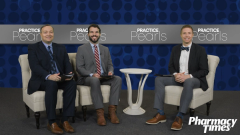
Proteosome Inhibitors in Combination Therapy
Experts discuss the role of proteasome inhibitors in combination therapy in the management of relapsed indolent multiple myeloma.
Ryan Haumschild, PharmD, MS, MBA: Dr Hinojosa, one thing we know when we’re looking at proteasome inhibitors is [that] they’re used in a lot of combination regimens, and these combination regimens vary with other mechanisms that complement each other in the care of the patient. We also know that not only do we use them in combination products but [also that] the combinations may change as a patient goes through different relapses. If you could give us an overview, what are the medications we typically combine with a proteasome inhibitor, and how does that combination change based on where that patient is within their relapse or treatment journey?
Gabe Hinojosa, PharmD, BCOP:Luckily for us, proteasome inhibitors tend to play nicely with most of their colleagues. We see them combined with drugs of many different classes. Our traditional backbone to the myeloma therapy is going to be our proteasome inhibitor, an immune modulatory agent, and dexamethasone as well. As these patients progress through their treatment, their induction therapy vs maintenance therapy tends to look very different. Particularly in our patients [with] standard-risk [disease], that proteasome inhibitor may fall off when they’re getting to their maintenance therapy. In the case of a patient with an indolent relapse, that may be an excellent opportunity to add that proteasome inhibitor back into the mix. So if the patient responded well to that drug initially and has had a good durable remission overall, tolerated the drug well, and didn’t have a lot of toxicity, that can be an excellent time to add that proteasome inhibitor back in, even in the setting of indolent relapse during maintenance therapy.
Ryan Haumschild, PharmD, MS, MBA: Dr Anderson, is there anything you want to add based on your clinical experience of where you see proteasome inhibitors being used? Also, will we continue to see additional therapies combined? Because I know we’re always trying to [achieve] balance. Will this additional therapy or synergistic effect improve efficacy, but [also], what is it going to do with [regard to] safety and tolerability?
Larry Anderson, MD, PhD, FACP: Typically adding back an antiproteasome inhibitor at relapse is going to be one of the main options. If the patient’s never had a CD38 antibody in the front line, that’s going to be a no-brainer to add that in the second line. So often that would be a CD38 [antibody] plus proteasome inhibitor. Let’s say they were [experiencing relapse] on an IMiD [immunomodulatory drug]. Then we’ll just switch classes over and have a 3-drug therapy with different classes. If that is not doing the trick, then that’s when we’d think about adding a fourth drug to that regimen. Once we’re getting more into the later-line relapses, we’re talking about combining with some of the immune therapies. A lot of studies are now looking at how we can combine these traditional myeloma therapies or novel therapies with immune therapies. So when we, for example, add a monoclonal antibody to a proteasome inhibitor, it typically doesn’t significantly increase the toxicity. We don’t yet know whether combining some of these drugs with the newer immune therapies, the T-cell–engaging therapies, is going to have any increase in toxicity. But combining these things over time is going to be key.
Transcript edited for clarity.
Newsletter
Stay informed on drug updates, treatment guidelines, and pharmacy practice trends—subscribe to Pharmacy Times for weekly clinical insights.




















































































































































































































